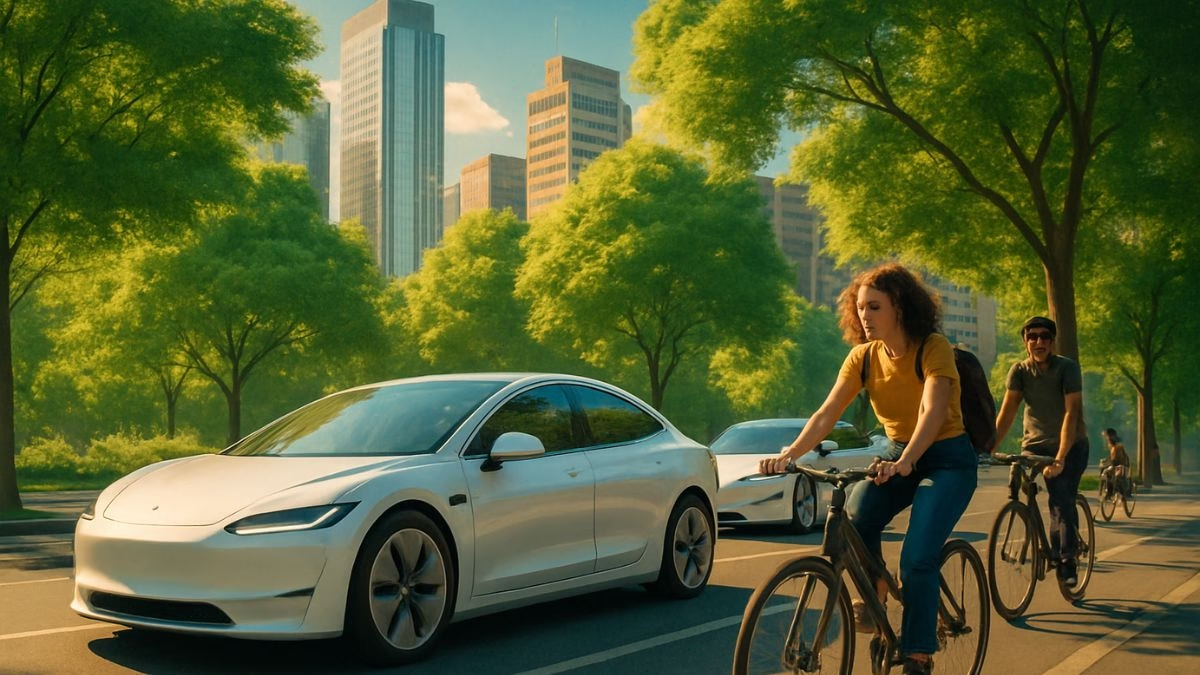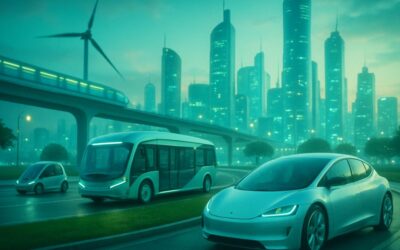Welcome to your advanced grammar workout! The best way to master complex English structures is to see them in action. In this lesson, we’re going to do just that.
First, you’ll read an article about the benefits of eco-friendly transportation. Don’t worry about the grammar just yet; simply read it to understand the main ideas. Then, we’ll roll up our sleeves and dissect some of the most interesting and high-level grammatical structures used in the text. This “read first, analyze second” approach helps you see the grammar in its natural habitat before putting it under the microscope. Ready? Let’s dive in.
The Quiet Revolution: Why Our Cities Are Embracing Greener Journeys
For over a century, the symphony of urban life has been dominated by the roar of the internal combustion engine. Our cities, designed around the automobile, have become sprawling networks of asphalt and concrete, often at the expense of human well-being and environmental health. However, a quiet revolution is underway. Embracing a philosophy that prioritizes sustainability, urban planners and citizens alike are beginning to champion a shift towards eco-friendly transportation, a move that promises to redefine the very essence of modern living. Had governments invested more in sustainable infrastructure decades ago, our cities would now be much healthier places to live.
The most compelling argument for this transition is, without a doubt, the environmental one. The transportation sector is a colossal contributor to greenhouse gas emissions, fueling climate change with relentless efficiency. Not only do traditional cars, buses, and trucks pump carbon dioxide into the atmosphere, but they also release a cocktail of other pollutants, such as nitrogen oxides and particulate matter, which are directly harmful to human health. Electric vehicles (EVs), powered by increasingly renewable energy grids, offer a direct solution to tailpipe emissions. The transition, however, is not merely about swapping a petrol engine for a battery. What is truly transformative is the broader move towards active transport and efficient public transit systems. It is this holistic approach that promises the most profound impact.
This brings us to the personal and public health benefits, which are impossible to overstate. Choosing to cycle or walk instead of drive is one of the most effective ways to integrate physical activity into a daily routine. This simple switch combats sedentary lifestyles, reducing the risk of chronic diseases like obesity, diabetes, and cardiovascular conditions. Furthermore, lower traffic volumes and fewer polluting vehicles lead to cleaner air. For residents of densely populated cities, this could mean a significant reduction in respiratory illnesses. It is often the unseen benefit of cleaner air that proves most vital for long-term community health.
From an economic perspective, the logic is equally sound. While the initial investment in infrastructure like dedicated bike lanes and expanded metro lines can be substantial, the long-term savings are enormous. Reduced traffic congestion, for instance, saves billions in lost productivity and wasted fuel. Individuals, freed from the financial burden of car ownership—including fuel, insurance, and maintenance—find themselves with more disposable income. Moreover, cities that are pleasant to walk and cycle in tend to attract more tourism and investment, creating a vibrant local economy. It’s a classic win-win scenario, where policies that are good for the planet also happen to be good for the wallet.
Of course, this transition is not without its hurdles. It is essential that governments provide the necessary regulatory framework and incentives to encourage the uptake of greener transport options. This requires careful urban planning, significant public and private investment, and, perhaps most importantly, a shift in public mindset. For generations, the car has been sold as a symbol of freedom and status. Reimagining it as just one of many mobility tools requires a cultural paradigm shift. But the momentum is building. With the rise of e-bikes making cycling accessible to more people, and shared mobility services providing convenient alternatives to car ownership, the pieces of a new transportation puzzle are falling into place.
Ultimately, the move towards eco-friendly transportation is about more than just reducing our carbon footprint; it’s about building cities that are more livable, equitable, and resilient. It’s about creating urban spaces where the air is cleaner, the streets are safer, and the connection between people and their environment is stronger. We stand at a critical juncture. Having witnessed the detrimental effects of a car-centric world, we now have the opportunity to build a better future. The journey of a thousand miles begins with a single step—or, perhaps, a single pedal stroke.
Grammar Deep Dive
Alright, how was the reading? Now for the fun part! Let’s pull out some of the grammatical gems from that text and see what makes them tick.
1. Participle Clauses: The Art of Being Concise
Text Example: “Embracing a philosophy that prioritizes sustainability, urban planners and citizens alike are beginning to champion a shift…”
What you’re seeing here is a present participle clause. Think of it as a super-efficient way to combine two ideas into one smooth sentence. Instead of saying:
- “Urban planners and citizens are embracing a philosophy that prioritizes sustainability. They are beginning to champion a shift…” (Two separate sentences)
We use the ‘-ing’ form (the present participle) to create a clause that adds background information to the main subject (“urban planners and citizens”). It elegantly tells us what they are doing or why they are doing it as they perform the main action of the sentence.
- When to use it: It’s fantastic for formal writing and for making your sentences more fluid and less repetitive. It connects ideas logically, often showing cause, result, or a simultaneous action.
- Common Mistake: A “dangling participle”! This happens when the subject of the participle clause is not the same as the subject of the main clause. For example: “Walking down the street, the buildings were beautiful.” This incorrectly implies the buildings were walking! The correct form would be: “Walking down the street, I saw beautiful buildings.“
2. Mixed Conditionals: Talking About a Different Past and Present
Text Example: “Had governments invested more in sustainable infrastructure decades ago, our cities would now be much healthier places to live.“
This beautiful sentence is a mixed conditional. It mixes the past with the present. It’s used to talk about a hypothetical past situation and its present result.
Let’s break it down:
- The ‘If’ Clause: Had governments invested… This is a fancy, inverted way of saying If governments had invested… (Past Perfect). It describes an unreal situation in the past. They didn’t invest enough.
- The ‘Result’ Clause: …our cities would now be… This part uses would + base verb. It describes the unreal present result of that hypothetical past action.
Essentially, you’re saying: Past Action (didn’t happen) → Present Result (is not true).
- Comparison: A standard Third Conditional talks about a past action and a past result (e.g., “If they had invested, the project would have succeeded.”). A Second Conditional talks about a hypothetical present and a future/present result (e.g., “If I had more money, I would travel now.”). The mixed conditional is your go-to for linking a different past to a different present.
- Common Mistake: Mixing up the tenses. Learners often forget to use the past perfect in the ‘if’ clause or use would have been in the result clause, which would make it a standard third conditional.
3. Inversion: Adding Emphasis and Formality
Text Example: “Not only do traditional cars, buses, and trucks pump carbon dioxide into the atmosphere, but they also release a cocktail of other pollutants…“
This is a classic example of inversion for emphasis. Normally, the sentence would be: “Traditional cars… not only pump carbon dioxide… but they also release…”. It’s perfectly correct, but a bit plain.
By starting with a negative or limiting adverbial like “Not only,” we invert the subject and the auxiliary verb.
- Standard order: Subject + Auxiliary Verb (e.g., They do…)
- Inverted order: Auxiliary Verb + Subject (e.g., do they…)
This structure immediately grabs the reader’s attention and adds a formal, sophisticated flair. It signals that a second, related point is coming (the “but also” part). Other phrases that trigger this kind of inversion include: Never before…, Hardly had I…, Under no circumstances…, Seldom do we see…
- How it works: Think of how you form a question: You are ready. → Are you ready?. The subject-verb order flips. Inversion does the same thing, but for emphasis, not to ask a question.
- Common Mistake: Forgetting to invert! Many students write: “Not only they do pump…” Remember, the phrase at the beginning is the trigger that forces the subject and auxiliary verb to switch places.
4. Cleft Sentences: Highlighting What’s Important
Text Example: “What is truly transformative is the broader move towards active transport…“
And also: “It is this holistic approach that promises the most profound impact.“
These are both cleft sentences. “Cleft” means “split.” These sentences split a single clause into two parts to emphasize one particular piece of information. They are incredibly common in spoken English and very useful in writing for creating focus.
There are two main types:
- ‘What’ Cleft: What + [clause] + is/was + [emphasized information].
- It takes the idea “The broader move is truly transformative” and highlights “the broader move.” It’s like pointing a finger and saying, “THIS is the important part.”
- ‘It’ Cleft: It + is/was + [emphasized information] + that/who + [rest of clause].
- It takes the idea “This holistic approach promises the most profound impact” and shines a spotlight on “this holistic approach.”
- Why use them? To guide your reader’s attention. In an exam, using a cleft sentence shows you can manipulate sentence structure to create emphasis, which is a high-level skill.
- Common Mistake: Creating grammatically awkward structures. The key is that if you remove the What…is or It is…that part, you should be left with a simple, logical sentence.
Your Turn to Practice!
So, we’ve explored how participle clauses make your writing concise, how mixed conditionals connect the past and present, how inversion adds punch, and how cleft sentences create focus.
These aren’t just obscure rules; they are powerful tools used by native speakers and skilled writers to make their communication more precise, elegant, and impactful. The next time you read an article, watch a film, or listen to a podcast, be a “grammar detective.” Try to spot these structures. The more you notice them, the more natural it will feel to use them in your own speaking and writing. Keep practicing, and you’ll be communicating with greater sophistication in no time! Good luck!










0 Comments